绿野仙踪英语课外阅读教学设计
幼儿园英语绘本教学《绿野仙踪》
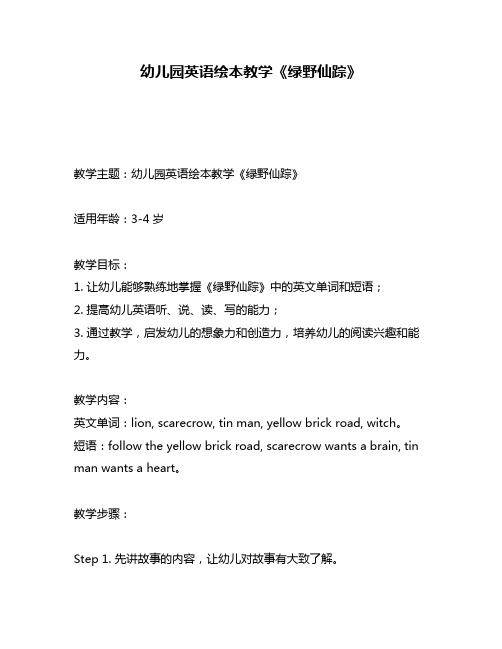
幼儿园英语绘本教学《绿野仙踪》教学主题:幼儿园英语绘本教学《绿野仙踪》适用年龄:3-4岁教学目标:1. 让幼儿能够熟练地掌握《绿野仙踪》中的英文单词和短语;2. 提高幼儿英语听、说、读、写的能力;3. 通过教学,启发幼儿的想象力和创造力,培养幼儿的阅读兴趣和能力。
教学内容:英文单词:lion, scarecrow, tin man, yellow brick road, witch。
短语:follow the yellow brick road, scarecrow wants a brain, tin man wants a heart。
教学步骤:Step 1. 先讲故事的内容,让幼儿对故事有大致了解。
The story is about a girl named Dorothy, who is in a land far away from home. Along the way, she meets a lion, a scarecrow, and a tin man. They go on an adventure together to find the Wizard of Oz, who can help them. They follow the yellow brick road and finally come to the witch's castle. They defeat the witch and finally arrive at the Wizard's palace.Step 2. 重点介绍英文单词和短语。
在教学时,可以先展示相关图片,让幼儿直观地了解物品和角色。
例如,将外貌有特色的狮子、稻草人和铁皮人的图片展示给幼儿,然后模仿声音和表情来描述它们。
然后再教他们单词lion, scarecrow, tin man。
同样,也可以用图片来展现黄砖路和女巫,并让幼儿学习和熟记yellow brick road和witch。
高中英语 Unit 3 On the move 英美文化欣赏教案 外研版必修
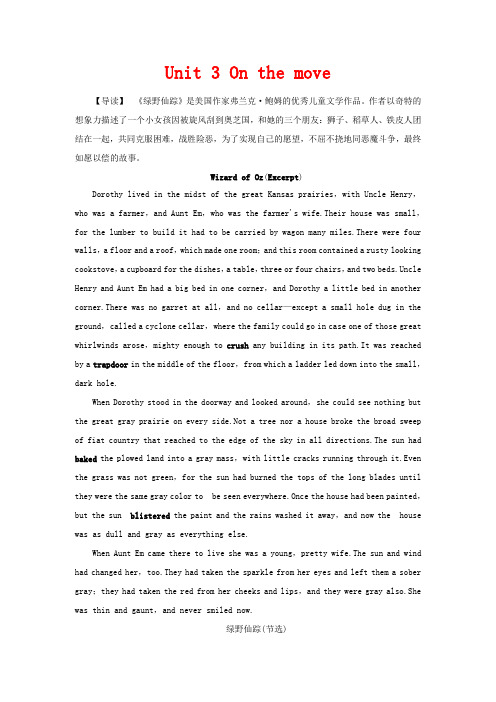
Unit 3 On the move【导读】《绿野仙踪》是美国作家弗兰克·鲍姆的优秀儿童文学作品。
作者以奇特的想象力描述了一个小女孩因被旋风刮到奥芝国,和她的三个朋友:狮子、稻草人、铁皮人团结在一起,共同克服困难,战胜险恶,为了实现自己的愿望,不屈不挠地同恶魔斗争,最终如愿以偿的故事。
Wizard of Oz(Excerpt)Dorothy lived in the midst of the great Kansas prairies,with Uncle Henry,who was a farmer,and Aunt Em,who was the farmer's wife.Their house was small,for the lumber to build it had to be carried by wagon many miles.There were four walls,a floor and a roof,which made one room;and this room contained a rusty looking cookstove,a cupboard for the dishes,a table,three or four chairs,and two beds.Uncle Henry and Aunt Em had a big bed in one corner,and Dorothy a little bed in another corner.There was no garret at all,and no cellar—except a small hole dug in the ground,called a cyclone cellar,where the family could go in case one of those great whirlwinds arose,mighty enough to crush any building in its path.It was reached by a trapdoor in the middle of the floor,from which a ladder led down into the small,dark hole.When Dorothy stood in the doorway and looked around,she could see nothing but the great gray prairie on every side.Not a tree nor a house broke the broad sweep of fiat country that reached to the edge of the sky in all directions.The sun had baked the plowed land into a gray mass,with little cracks running through it.Even the grass was not green,for the sun had burned the tops of the long blades until they were the same gray color to be seen everywhere.Once the house had been painted,but the sun blistered the paint and the rains washed it away,and now the house was as dull and gray as everything else.When Aunt Em came there to live she was a young,pretty wife.The sun and wind had changed her,too.They had taken the sparkle from her eyes and left them a sober gray;they had taken the red from her cheeks and lips,and they were gray also.She was thin and gaunt,and never smiled now.绿野仙踪(节选)多萝茜与亨利叔叔、爱姆婶婶,一起住在堪萨斯州大草原中部的小木屋里。
幼儿园英语启蒙课程教案:《绿野仙踪》
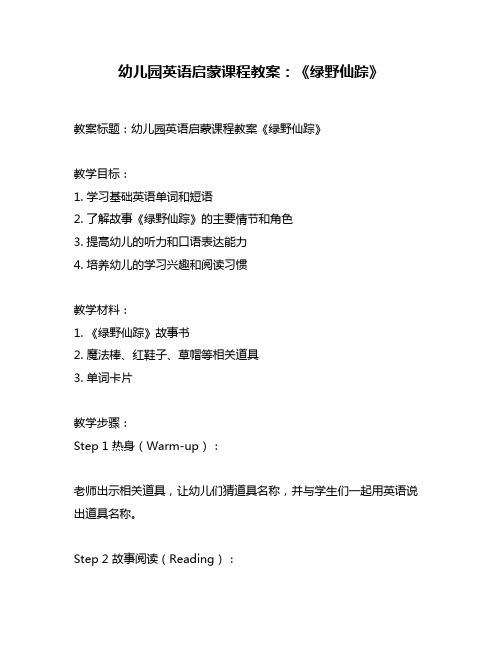
幼儿园英语启蒙课程教案:《绿野仙踪》教案标题:幼儿园英语启蒙课程教案《绿野仙踪》教学目标:1. 学习基础英语单词和短语2. 了解故事《绿野仙踪》的主要情节和角色3. 提高幼儿的听力和口语表达能力4. 培养幼儿的学习兴趣和阅读习惯教学材料:1. 《绿野仙踪》故事书2. 魔法棒、红鞋子、草帽等相关道具3. 单词卡片教学步骤:Step 1 热身(Warm-up):老师出示相关道具,让幼儿们猜道具名称,并与学生们一起用英语说出道具名称。
Step 2 故事阅读(Reading):老师朗读《绿野仙踪》故事,让幼儿们聆听故事情节,并带领幼儿们模仿发音和模拟情境,让幼儿在有趣的环境中积累单词和短语。
Step 3 单词学习(Vocabulary):老师通过单词卡片的方式,向幼儿们介绍与故事相关的单词逐一讲解,让幼儿们学会拼读出基础单词,口语表达中常用的短语。
Step 4 对话表演(Dialogue):老师邀请幼儿们参与对话表演,让每个幼儿扮演故事中不同的角色,并要求幼儿们使用他们学习过的单词和短语来完成对话表演,从而帮助他们在语言环境中提高英语口语表达能力。
Step 5 制作道具(Prop-making):老师带领幼儿们制作与故事相关的道具,如绿野仙踪中的魔法棒、红鞋子、草帽等道具,让幼儿们体验英语学习的乐趣。
Step 6 情景模拟(Role-play):老师安排幼儿们进行情景模拟,让幼儿在模拟情境中使用他们学习过的单词和短语来表达,如模拟找道路的场景,让幼儿们用英语指出该走的方向。
Step 7 手工制作(Handicraft):老师带领幼儿们制作和故事相关的手工作品,如制作小狮子、黄砖路等,让幼儿们在制作的过程中提高动手能力和英语学习的兴趣。
Step 8 总结(Summary):老师总结本节课学习内容和进度,让幼儿们回忆所学过的单词和短语,并鼓励幼儿们练习口语表达,以便在之后的学习中能够熟练掌握。
Step 9 家庭作业(Homework):老师布置家庭作业,让幼儿完成与故事相关的作业,如画故事场景、复习单词和短语等,从而帮助幼儿巩固所学内容。
《绿野仙踪》阅读指导课教案

《绿野仙踪》阅读指导课教案第一章:课程导入一、教学目标1. 激发学生对《绿野仙踪》的阅读兴趣。
2. 引导学生了解本书的作者、背景及主要人物。
二、教学内容1. 本书的作者:弗兰克·鲍姆。
2. 本书的背景:美国,19世纪末。
3. 本书的主要人物:多萝西、稻草人、铁皮人和胆小的狮子。
三、教学步骤1. 向学生介绍本书的作者、背景及主要人物。
2. 通过问题引导学生思考:你们觉得这本书的故事会发生在哪里?主要人物会经历怎样的冒险?3. 邀请学生分享他们对本书的期待和好奇心。
四、教学评价1. 观察学生在课堂上的参与程度,了解他们对本书的兴趣。
2. 记录学生在分享环节提出的问题和想法,评估他们对本书的期待程度。
第二章:故事梗概介绍一、教学目标1. 帮助学生了解《绿野仙踪》的故事梗概。
2. 引导学生关注本书的主要情节和冲突。
二、教学内容1. 本书的故事梗概:多萝西被龙卷风带到了奥兹国,结识了稻草人、铁皮人和胆小的狮子,一起寻找回家的路,并在旅程中经历了种种冒险。
2. 本书的主要情节和冲突:多萝西和她的朋友们在寻找回家的路过程中,遇到了许多困难和挑战,如遇到邪恶的西方女巫、陷入困境的稻草人、铁皮人和胆小的狮子等。
三、教学步骤1. 向学生介绍本书的故事梗概。
2. 通过问题引导学生关注本书的主要情节和冲突。
3. 邀请学生分享他们对故事梗概的理解和感受。
四、教学评价1. 观察学生在课堂上的参与程度,了解他们对故事梗概的理解。
2. 记录学生在分享环节提出的问题和想法,评估他们对主要情节和冲突的关注程度。
第三章:角色分析一、教学目标1. 帮助学生了解《绿野仙踪》中的主要角色。
2. 引导学生分析角色的特点和动机。
二、教学内容1. 多萝西:一个善良、勇敢、充满好奇心的女孩。
2. 稻草人:一个聪明、善良、有责任心的角色。
3. 铁皮人:一个勇敢、坚定、有爱心的角色。
4. 胆小的狮子:一个勇敢、自信、有领导力的角色。
三、教学步骤1. 向学生介绍本书的主要角色。
黑布林英语阅读系列The Wizard of OZ《绿野仙》教案教学设计

黑布林英语阅读系列—《绿野仙踪》教学设计Appreciation of The Wonderful Wizard of Oz Teaching aims:1. Students get some basic information about the story, like the author, characters and plots;2. Arouse students’ interest in reading the book;3. Students get some reading skills about how to read a book. Teaching procedures:Step1: General introductionAsk ss to take out their books and look at the cover. Ask:T: What is the name of the book?S:The Wonderful Wizard of Oz.T:What do you think of this novel(小说)?S: I think it’s…Step2: Predict with the pictures1.Who are they?2.What are they going to do?3.How do their dreams come true?Step3: How to read a novel— The Wonderful Wizard of Oz Three parts: 1.background 2.characters 3.plots1.Backgrounda.)Fill in the profile of the author :Lyman Frank Baumb.)Learn about the book (Page7/Part1), fill in the blanks.2.Characters1.)Introduce each character (fill in the blanks and read together)A.This is...She doesn’t have ...She is an…She lives with …in Kansas. Her dog is her only ....Its name is...B.This is the Scarecrow. He is made of _____.He doesn’t have a ____.He is afraid of ____.the Scarecrow : This is the Scarecrow. He is made of _____.He doesn’t have a ____.He is afraid of ____.Tin woodman:…be made of……not have a……be afraid of …the Cowardly Lion :This is the Cowardly Lion.He is not as _____ as other lions.He doesn’t have any _______.2).Help students read the contents and know the main idea of each chapter by reading the titles3).Learn some important words and phrases: orphan, straw, brain, brave, courage, be made of , be afraid of…3.Plotsa)Read the novel The Wonderful Wizard of Oz, answer thequestions.1.How may chapters (章节)are there in the novelThe Wonderful Wizard of Oz ?2. What does each chapter talk about? ( Discussion)b) Look at the video about Chapter One.Ask: What can you see in the video?Answer: I can see …At last, the flying house hit the ground , it came to the land of the Munchkins.C) Chapter 2: The land of the Munchkins1.) Listen, read and complete (Page20—21)The men in blue are _________Circle the Witch of the North in the picture.2.) Read the dialogue between the witch and Dorothy. Try your best to imitate.d) What happens in the story? Put the events a)-j) on the timeline in the correct order.( Page 86)e) Circle the correct answer. There are ten questions, choose the best answer of the three.(Page91)Step4: Shows1.After reading the novel, answer the questions below, work inpairs.A: What is the difference(不同) between the land of Munchkins and the prairies of Kansas?B: …A: How does Dorothy help the Tin Woodman when he doesn’tmove(移动)?B: …A: What does the Wizard of Oz say when four friends want hishelp?B: …A: How does the Wizard of Oz help the four friends?B: …A: Is the Wizard a good person or a bad person?B: I think he is a good person, because …/I think he is a bad person, because …2.Write a book report:After reading the novel , write down your feelings。
绿野仙踪 教案 英文
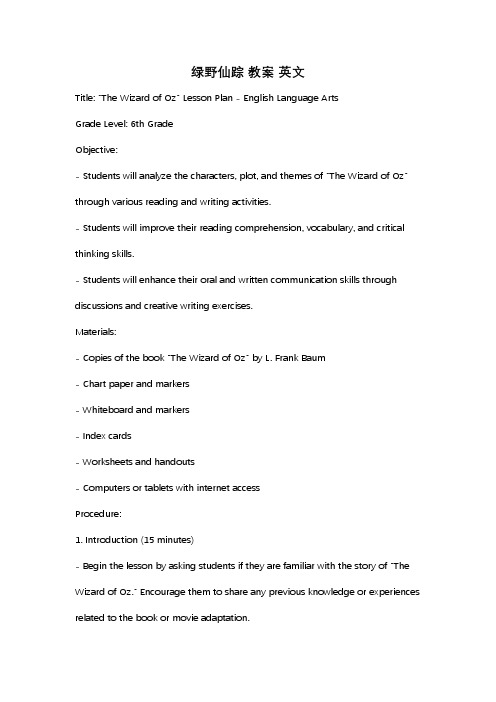
绿野仙踪教案英文Title: "The Wizard of Oz" Lesson Plan - English Language ArtsGrade Level: 6th GradeObjective:- Students will analyze the characters, plot, and themes of "The Wizard of Oz" through various reading and writing activities.- Students will improve their reading comprehension, vocabulary, and critical thinking skills.- Students will enhance their oral and written communication skills through discussions and creative writing exercises.Materials:- Copies of the book "The Wizard of Oz" by L. Frank Baum- Chart paper and markers- Whiteboard and markers- Index cards- Worksheets and handouts- Computers or tablets with internet accessProcedure:1. Introduction (15 minutes)- Begin the lesson by asking students if they are familiar with the story of "The Wizard of Oz." Encourage them to share any previous knowledge or experiences related to the book or movie adaptation.- Show the students the book cover and briefly discuss the author, L. Frank Baum, and the significance of the book's title, "The Wizard of Oz."- Introduce the objectives of the lesson and explain how the activities will help them deepen their understanding of the story.2. Pre-Reading Activity: Vocabulary (20 minutes)- Provide students with a list of vocabulary words related to the story. Examples include "tornado," "emerald," "munchkins," and "courage."- Instruct students to work individually or in pairs to define the words and write sentences using them.- Have students share their definitions and sentences with the class, facilitating a brief discussion to ensure understanding.3. Reading and Comprehension (40 minutes)- Divide the class into small groups and distribute copies of the book "The Wizard of Oz."- Assign each group a specific number of chapters to read, ensuring that the entire book is covered by the end of the lesson.- Instruct students to read their assigned chapters and take notes on important events, characters, and themes.- After reading, regroup the students so that each new group has at least one member who read each chapter.- Facilitate a whole-class discussion where each group presents their findings, allowing students to compare and contrast their notes.4. Character Analysis (30 minutes)- Provide each student with an index card and ask them to choose one character from the story.- Instruct students to write the name of the character on one side of the index card and three adjectives that describe the character on the other side.- Once completed, have students share their chosen character and adjectives with the class, explaining their choices.- As a class, create a character analysis chart on chart paper or the whiteboard, summarizing the students' findings.5. Creative Writing Activity: Alternate Ending (30 minutes)- Explain to students that they will have the opportunity to rewrite the ending of "The Wizard of Oz" based on their own imagination.- Encourage students to think creatively and consider how they could change the story's outcome or add new elements.- Provide worksheets with writing prompts or graphic organizers to guide students in their writing process.- Allow time for students to write their alternate endings individually.- Optional: Students can share their alternate endings with the class or in small groups, fostering discussion and creativity.6. Conclusion (10 minutes)- Recap the main points discussed throughout the lesson, emphasizing the importance of analyzing characters, themes, and plot in literature.- Encourage students to continue exploring different literary works and to apply their critical thinking skills to other texts.- Provide a brief opportunity for students to ask questions or share any final thoughts on the lesson.Note: The duration of each activity can be adjusted based on the specific needs and time constraints of the class. It is important to maintain flexibility and adapt the lesson plan accordingly.。
《绿野仙踪》阅读指导课教案

《绿野仙踪》阅读指导课教案第一章:课程介绍1.1 教学目标了解《绿野仙踪》的作者、背景及主题。
培养学生对经典文学作品的阅读兴趣。
提高学生阅读理解能力和文学鉴赏能力。
1.2 教学内容作品简介:《绿野仙踪》是美国作家L. Frank Baum创作的一部经典儿童文学作品,讲述了主人公多萝西在堪萨斯州的家乡被龙卷风卷走后,与稻草人、铁皮人和胆小的狮子一起在奇幻的奥兹国经历了一系列冒险,最终实现各自愿望的故事。
作品主题:友情、勇气、智慧、家。
1.3 教学方法采用问题引导、小组讨论、个人思考等教学方法,激发学生的阅读兴趣和思考能力。
通过分析作品的情节、人物、语言等特点,培养学生的文学鉴赏能力。
第二章:作者及作品背景介绍2.1 教学目标了解《绿野仙踪》的作者L. Frank Baum的生平和创作背景。
理解作品的时代背景对故事情节和人物塑造的影响。
2.2 教学内容作者简介:L. Frank Baum(1856-1919),美国作家,被誉为“童话之父”,创作了众多儿童文学作品,其中《绿野仙踪》最为著名。
作品背景:19世纪末的美国,正处于工业化和现代化的转型期,社会变革和矛盾冲突为作品提供了丰富的素材。
2.3 教学方法通过查阅资料、观看相关视频等方式,了解作者的生平和创作背景。
引导学生从时代背景的角度分析作品,理解作品中所反映的社会现象和价值观。
第三章:情节梳理3.1 教学目标掌握《绿野仙踪》的故事情节,理解各个人物的特点和动机。
培养学生对作品情节的分析和概括能力。
3.2 教学内容故事情节:多萝西被龙卷风卷到奥兹国,结识了稻草人、铁皮人和胆小的狮子,一起经历了寻找魔法师、战胜西方女巫等冒险,回到堪萨斯州。
人物分析:多萝西:纯真、善良、勇敢;稻草人:渴望智慧;铁皮人:渴望亲情;胆小的狮子:渴望勇气。
3.3 教学方法引导学生通读作品,概括故事情节和人物动机。
通过小组讨论、问题回答等方式,分析人物性格特点和作品主题。
第四章:作品主题探讨4.1 教学目标深入理解《绿野仙踪》中的友情、勇气、智慧、家等主题。
《绿野仙踪》整本书阅读教案
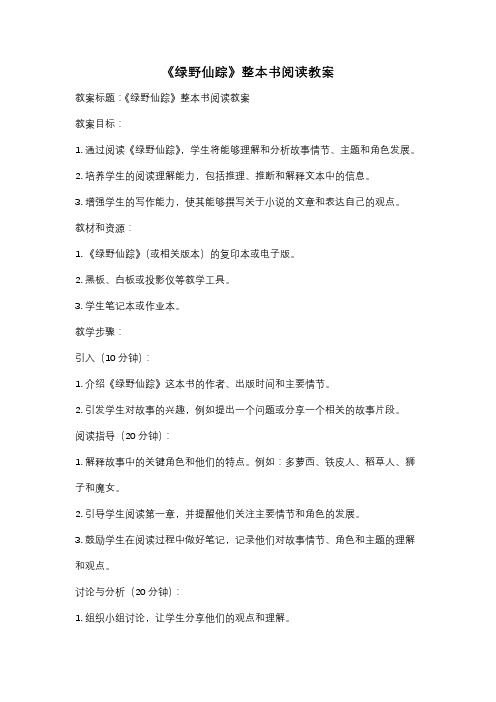
《绿野仙踪》整本书阅读教案教案标题:《绿野仙踪》整本书阅读教案教案目标:1. 通过阅读《绿野仙踪》,学生将能够理解和分析故事情节、主题和角色发展。
2. 培养学生的阅读理解能力,包括推理、推断和解释文本中的信息。
3. 增强学生的写作能力,使其能够撰写关于小说的文章和表达自己的观点。
教材和资源:1. 《绿野仙踪》(或相关版本)的复印本或电子版。
2. 黑板、白板或投影仪等教学工具。
3. 学生笔记本或作业本。
教学步骤:引入(10分钟):1. 介绍《绿野仙踪》这本书的作者、出版时间和主要情节。
2. 引发学生对故事的兴趣,例如提出一个问题或分享一个相关的故事片段。
阅读指导(20分钟):1. 解释故事中的关键角色和他们的特点。
例如:多萝西、铁皮人、稻草人、狮子和魔女。
2. 引导学生阅读第一章,并提醒他们关注主要情节和角色的发展。
3. 鼓励学生在阅读过程中做好笔记,记录他们对故事情节、角色和主题的理解和观点。
讨论与分析(20分钟):1. 组织小组讨论,让学生分享他们的观点和理解。
2. 引导学生分析故事中的主题和情节发展,例如友谊、勇气和家的意义等。
3. 引导学生思考作者在故事中传达的信息和价值观。
写作任务(15分钟):1. 要求学生撰写一篇关于《绿野仙踪》的文章,可以选择以下主题之一:a. 描述你最喜欢的角色,并解释为什么。
b. 分析故事中的一个主题,并提供支持你观点的证据。
c. 比较多萝西在故事开始和结束时的变化,并解释其原因。
2. 提醒学生在文章中使用适当的论据和引用来支持他们的观点。
总结与评估(10分钟):1. 邀请学生分享他们的写作成果,并提供互相反馈。
2. 对学生的阅读理解和写作进行评估,并提供指导和建议。
延伸活动:1. 邀请学生进行角色扮演或小剧场表演,以更深入地理解故事情节和角色。
2. 组织学生参加小组讨论或辩论,探讨故事中的伦理和道德问题。
3. 鼓励学生阅读其他与《绿野仙踪》相关的作品,例如其他奥兹系列的书籍或改编的电影。
《绿野仙踪》阅读指导课教案(改)

《绿野仙踪》阅读指导课教案(改)第一章:课程概述一、教学目标1. 让学生了解《绿野仙踪》的作者、背景及作品特点。
2. 培养学生的阅读兴趣,提高阅读能力。
3. 引导学生理解作品主题,培养正确的价值观。
二、教学内容1. 作品简介:《绿野仙踪》是美国作家L. Frank Baum创作的一部奇幻小说,讲述了主人公多萝茜在Kansas 大草原上被龙卷风卷走后,穿越奇幻的奥兹国,与稻草人、铁皮人和胆小的狮子一起寻找回家之路的冒险故事。
2. 教学重点:了解作品背景,分析人物形象,品味语言风格。
3. 教学难点:深入理解作品主题,培养学生的批判性思维。
三、教学方法1. 采用问题驱动法,引导学生主动探究作品内容。
2. 运用案例分析法,深入剖析人物形象和情节。
3. 采用小组讨论法,培养学生的合作能力和口头表达能力。
四、教学准备1. 教师准备PPT,包括作品封面、人物形象、情节梗概等。
2. 学生准备《绿野仙踪》原著,提前阅读。
五、教学过程1. 导入:教师展示作品封面,引导学生回顾作品情节。
2. 作品简介:教师简要介绍作者和作品背景。
3. 人物分析:教师引导学生分析主要人物的性格特点。
4. 情节梳理:学生分享自己喜欢的片段,教师引导讨论。
5. 主题探讨:教师引导学生思考作品所传达的价值观。
第二章:案例分析一、教学目标1. 让学生通过案例分析,更深入地理解人物形象。
2. 培养学生运用批判性思维分析文学作品。
二、教学内容1. 选取具有代表性的案例,进行分析。
2. 引导学生从多角度审视人物形象。
三、教学方法1. 采用案例分析法,引导学生深入剖析人物形象。
2. 运用小组讨论法,培养学生的合作能力和批判性思维。
四、教学准备1. 教师准备案例,并进行PPT展示。
2. 学生提前阅读案例相关内容。
五、教学过程1. 导入:教师展示案例,引导学生关注。
2. 案例分析:教师引导学生从多角度分析人物形象。
3. 小组讨论:学生分小组讨论,分享自己的观点。
《绿野仙踪》阅读指导课教案

《绿野仙踪》阅读指导课教案一、教学目标:1. 通过阅读《绿野仙踪》,使学生了解和掌握作品的基本情节、人物关系和寓意。
2. 培养学生对经典文学作品的阅读兴趣,提高学生的文学素养。
3. 引导学生运用批判性思维,对作品中的主题、人物和情节进行分析与讨论。
二、教学内容:1. 作品背景介绍:《绿野仙踪》是美国作家弗兰克·鲍姆创作的一部奇幻小说,发表于1900年。
作品以19世纪美国中西部的干旱灾害为背景,讲述了一个关于勇气、友谊和勇气的的故事。
2. 人物关系梳理:Dorothy(多萝西)、Tin Man(铁皮人)、Scarecrow(稻草人)、Cowardly Lion(胆小狮)3. 主要情节概括:多萝西被龙卷风带到了奇幻的奥兹国,结识了铁皮人、稻草人和胆小狮,一起经历了寻找智慧、勇气和勇气的历程,最终成功回到家乡。
三、教学重点与难点:1. 教学重点:掌握《绿野仙踪》的基本情节、人物关系和寓意。
2. 教学难点:分析作品中的主题、人物和情节,培养学生的批判性思维。
四、教学方法:1. 讲授法:讲解作品背景、人物关系和主要情节。
2. 讨论法:引导学生对作品中的主题、人物和情节进行分析与讨论。
3. 案例分析法:选取具有代表性的情节和人物,进行深入剖析。
五、教学步骤:1. 导入:简要介绍《绿野仙踪》的背景和作者,激发学生的阅读兴趣。
2. 讲解人物关系:介绍多萝西、铁皮人、稻草人和胆小狮的性格特点和命运,使学生熟悉作品中的主要角色。
3. 概述主要情节:讲述多萝西和她的朋友们在奥兹国的冒险历程,包括寻找智慧、勇气和勇气的经历。
4. 分析作品寓意:引导学生从作品中发现勇气、友谊和勇气的主题,理解作品的价值观念。
5. 讨论与思考:让学生结合自己的生活经历,谈谈对作品中的主题、人物和情节的理解和感悟。
六、教学活动设计:1. 小组合作:将学生分成若干小组,每组选择一个角色(多萝西、铁皮人、稻草人、胆小狮),分析角色的性格特点、动机和成长历程。
绿野仙踪教案

绿野仙踪教案绿野仙踪教案一、教学目标1. 了解《绿野仙踪》的基本情节和主要人物。
2. 学习理解和运用故事中的主题和情感。
3. 提升阅读理解和写作能力。
二、教学重点1. 故事的基本情节和主要人物。
2. 故事的主题和情感。
三、教学难点理解和运用故事中的主题和情感。
四、教学准备1. 教师准备采购《绿野仙踪》的书籍。
2. 准备与故事相关的图片和视频素材。
3. 准备相关的练习和讨论问题。
五、教学过程1. 导入通过图片和视频来介绍《绿野仙踪》的故事背景和主题。
激发学生的兴趣和好奇心。
2. 学习理解让学生阅读或听教师讲述《绿野仙踪》的故事。
教师可以通过导读提醒学生注意故事中的重要情节和人物。
3. 故事讨论教师引导学生讨论以下问题:a. 故事中的主要人物有哪些?他们的特点和作用是什么?b. 故事中发生了哪些冒险和困难?c. 故事中传递了什么样的主题和情感?4. 主题理解引导学生理解和思考故事传递的主题,如勇敢、友谊、成长等。
鼓励学生从故事中找出例子来支持自己的观点。
5. 作文练习要求学生以《绿野仙踪》为题,写一篇关于自己的冒险经历或者让自己变得勇敢的经历的作文。
鼓励学生用自己的想象和创造力来写作。
六、课堂小结教师对本节课的教学进行总结,并鼓励学生继续阅读和探索更多的故事。
七、拓展延伸1. 鼓励学生阅读《绿野仙踪》的原版英文书籍,提高英语阅读能力。
2. 学生可以根据故事中的情节和主题来进行戏剧表演或者绘画创作。
八、教学反思本节课通过让学生阅读和讨论《绿野仙踪》的故事,培养了学生的阅读理解和写作能力,同时也帮助学生理解和运用故事中的主题和情感。
但需要注意的是,在引导学生思考主题和写作时,要充分记住学生的英语水平和年龄特点,避免过于复杂或抽象的探讨。
ThewonderfulWizardofOz教学设计
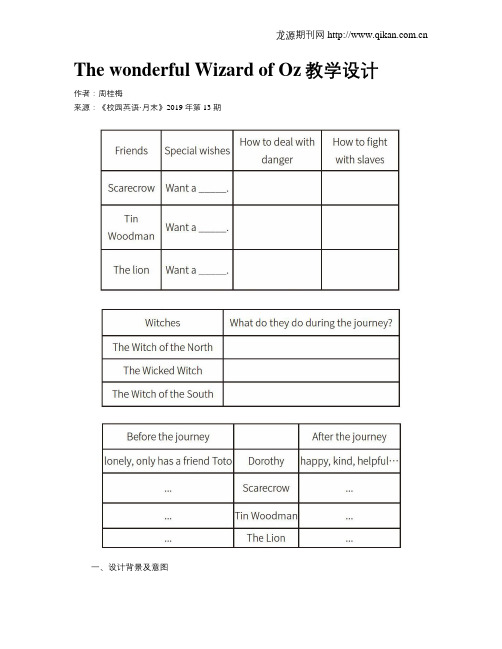
本节课的教学内容是津津有味系列之绿野仙踪The wonderful Wizard of Oz整本书的阅读课,它是美国作家弗兰克·鲍姆创作的奥兹国系列故事的第一部,讲述的是美丽善良的小姑娘多萝茜Dorothy被一场龙卷风刮到了一个陌生而神奇的国度——奥兹国。在那里,她陆续结识了没脑子的稻草人、没爱心的铁皮人和胆小的狮子,他们为了实现各自的心愿,互相帮助、携手合作,历尽艰险,遇到许多稀奇古怪的事情。最后,他们凭借自己非凡的智慧和顽强的毅力,都完成了自己的心愿。
3. Learn something from the main characters.
四、教学重难点
1. Learn to analyzen characters and experience their feelings.
2. Learn something from the main characters.
五、教學步骤
Step1:Enjoy the cover of The Wonderful Wizard of Oz
1. Ask the question:Do you like reading in your free time?
2. Show the cover of the book:What information can you know about the book from the cover?
The wonderful Wizard of Oz教学设计
作者:周桂梅
来源:《校园英语·月末》2019年第13期
一、设计背景及意图
针对现在学校初中学生英语名著阅读情况,教师指导学生阅读名著从简本读起,由易到难,鼓励引导学生阅读,提升学生的英语阅读能力。本教学设计旨在开展英语经典名著阅读指导教学时,启发学生走进故事,品味语言,体察人物的性格,感悟文学作品的主题意义,提升学生的英语思维品质。
绿野仙踪英语阅读教学设计
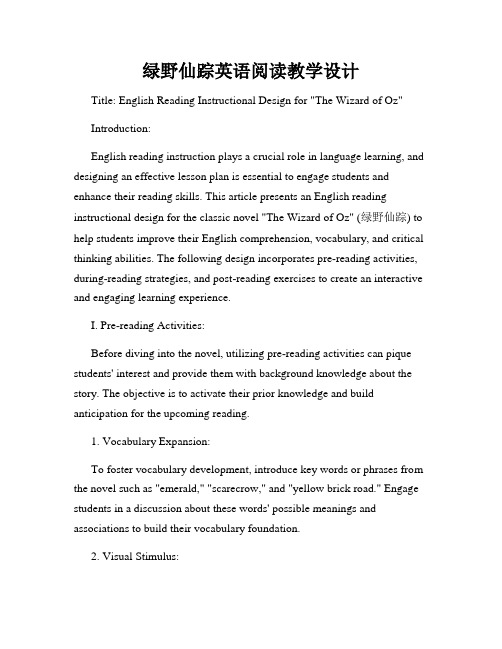
绿野仙踪英语阅读教学设计Title: English Reading Instructional Design for "The Wizard of Oz"Introduction:English reading instruction plays a crucial role in language learning, and designing an effective lesson plan is essential to engage students and enhance their reading skills. This article presents an English reading instructional design for the classic novel "The Wizard of Oz" (绿野仙踪) to help students improve their English comprehension, vocabulary, and critical thinking abilities. The following design incorporates pre-reading activities, during-reading strategies, and post-reading exercises to create an interactive and engaging learning experience.I. Pre-reading Activities:Before diving into the novel, utilizing pre-reading activities can pique students' interest and provide them with background knowledge about the story. The objective is to activate their prior knowledge and build anticipation for the upcoming reading.1. Vocabulary Expansion:To foster vocabulary development, introduce key words or phrases from the novel such as "emerald," "scarecrow," and "yellow brick road." Engage students in a discussion about these words' possible meanings and associations to build their vocabulary foundation.2. Visual Stimulus:Display images related to the story, such as the cover illustration of "The Wizard of Oz," on a projector or handouts. Encourage students to describe the pictures, make predictions about the plot, and share their thoughts or feelings evoked by the visual stimuli.II. During-reading Strategies:While students are engaged in reading the novel, incorporating various during-reading strategies can enhance their comprehension and encourage active reading.1. Reading Comprehension Questions:Prepare a set of comprehension questions related to each chapter or section of the novel. These questions should cover a range of reading skills, such as main idea identification, inference-making, and character analysis. Encourage students to answer these questions individually or engage in group discussions to strengthen their understanding of the text.2. Text Annotation:Instruct students to annotate the text while reading to highlight important details, unfamiliar vocabulary, or key events. Encourage them to use different annotation symbols such as underlining, circling, or jotting down notes in the margins. Remind them that this practice helps them actively engage with the text and facilitates easier review during post-reading activities.III. Post-reading Exercises:After completing the reading, it is crucial to reinforce students' comprehension, critical thinking, and language skills through a variety of post-reading exercises.1. Group Retelling and Acting:Divide students into small groups and assign each group a specific chapter or section of the novel. Instruct them to retell the main events, summarizing the plot, and assigning roles for each character. Encourage groups to act out their assigned sections, fostering creativity and presentation skills.2. Opinion Writing:Ask students to write a reflective or opinionated piece about their reading experience. Prompts can include questions such as "Which character did you identify with the most and why?" or "If you were in Dorothy's shoes, how would you approach the challenges faced in the story?" This exercise enables students to express their thoughts and engage in critical thinking while practicing their writing skills.Conclusion:By incorporating pre-reading activities, during-reading strategies, and post-reading exercises, this English reading instructional design for "The Wizard of Oz" aims to enhance students' reading comprehension, vocabulary acquisition, critical thinking, and language skills. Adapting this design to other texts can create an interactive and engaging learning environment that fosters students' love for reading and improves their overall English proficiency.。
绿野仙踪英语阅读教学设计

教学媒体选择
传统黑板:用于书 写重要词汇和句型
投影仪:展示绿野 仙踪的图片和视频 片段,帮助学生更 好地理解故事情节
音频设备:播放绿 野仙踪的原声带, 让学生模仿地道的 英语发音
互动白板:用于小 组讨论和展示,增 强学生的参与感和 互动性
PART FIVE
教学过程
导入环节
激活学生的前知:通过提问和讨论, 引导学生回忆相关的英语知识和经 验。
听说:通过模仿和 练习提高英语听说 能力
阅读:理解故事情 节和人物关系,培 养阅读技巧
PART FOUR
教学方法
激活学生的前知
利用学生已有 的知识和经验, 引导他们进入 绿野仙踪的世
界。
通过提问和讨 论,激发学生 的好奇心和探
究欲望。
提供相关的图 片、视频和资 料,帮助学生 更好地理解故 事情节和人物
创设情境:利用多媒体等手段,创 设与课文内容相关的情境,激发学 生的学习兴趣。
添加标题
添加标题
添加标题
添加标题
介绍教学目标:明确本节课的教学 目标和内容,让学生对学习有清晰 的认识。
组织活动:通过开展游戏、唱歌等 活动,调动学生的积极性,营造轻 松愉快的课堂氛围。
展开环节
导入:通过绿野仙 踪的故事背景和人 物角色,引起学生 的兴趣和好奇心。
能力目标
学生能够理解绿野 仙踪的故事情节和 主题
学生能够运用英语 阅读技巧,提高阅 读理解能力
学生能够通过小组 讨论和角色扮演等 活动,提高口语表 达和交际能力
学生能够通过阅读 绿野仙踪,培养想 象力和创造力
情感目标
增强学生的跨文化意识和国 际视野
培养学生对英语阅读的兴趣 和热爱
提高学生的阅读能力和阅读 技巧
幼儿园英语启蒙:《绿野仙踪》教案
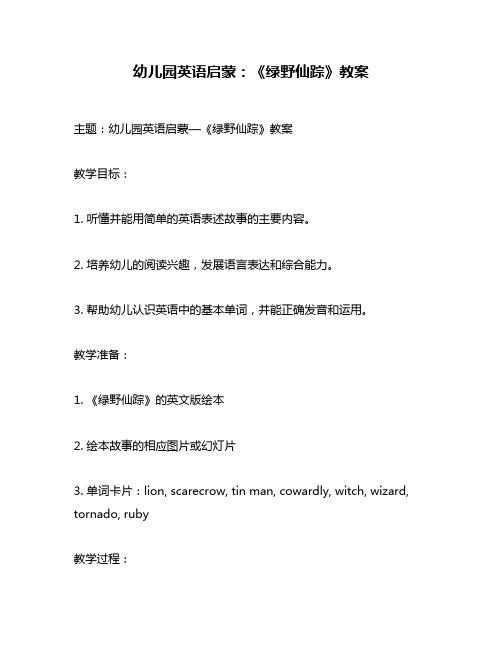
幼儿园英语启蒙:《绿野仙踪》教案主题:幼儿园英语启蒙—《绿野仙踪》教案教学目标:1. 听懂并能用简单的英语表述故事的主要内容。
2. 培养幼儿的阅读兴趣,发展语言表达和综合能力。
3. 帮助幼儿认识英语中的基本单词,并能正确发音和运用。
教学准备:1. 《绿野仙踪》的英文版绘本2. 绘本故事的相应图片或幻灯片3. 单词卡片:lion, scarecrow, tin man, cowardly, witch, wizard, tornado, ruby教学过程:Step 1:导入老师向幼儿介绍英语绘本《绿野仙踪》并简单介绍故事背景及主要人物,并展示相应图片。
Step 2:故事阅读老师播放CD,朗读英文版绘本。
幼儿一边阅读,一边听故事。
Step 3:故事理解老师教授以下重点单词,并让幼儿用简单的语言来表述故事的主要内容:lion, scarecrow, tin man, cowardly, witch, wizard, tornado, rubyStep 4:情节复述老师让幼儿回忆故事中的主要情节:Do you remember what happened to Dorothy in the story? Who did she meet? What happened when she met the witch?Step 5:情感分享老师向幼儿传达故事中传递的正能量,如勇敢、友谊、助人为乐。
Step 6:课堂活动1. 幼儿合作设计制作可以代表故事情节的海报。
2. 老师根据图示放置单词卡片,并让幼儿用拼音、认读单词卡片,完成基本词汇的学习。
3. 老师将多个首字母不同的单词拼成句子,让幼儿来拼读,并能翻译成中文。
Step 7:作业让幼儿在回家后,和家长一起重复复述故事,锻炼口语表达和阅读能力。
Step 8:总结老师与幼儿共同回顾当天所学的内容,强化对于英语单词、场景及故事情节的掌握,同时鼓励幼儿在日常生活中多加接触英语,提高英语听说能力。
幼儿园英语乐园:《绿野仙踪》绘本教学新探
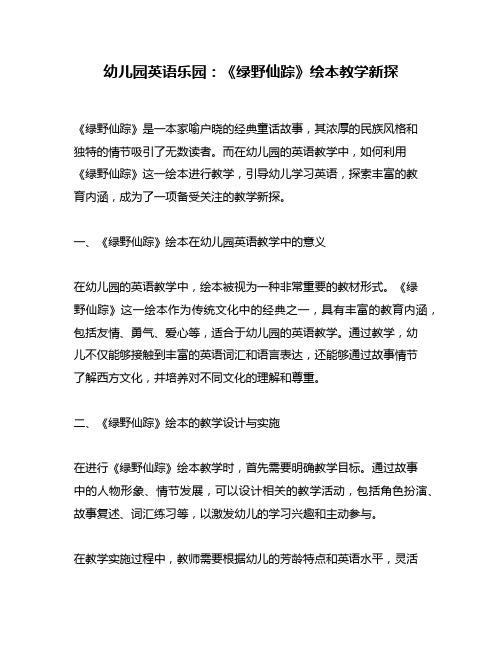
幼儿园英语乐园:《绿野仙踪》绘本教学新探《绿野仙踪》是一本家喻户晓的经典童话故事,其浓厚的民族风格和独特的情节吸引了无数读者。
而在幼儿园的英语教学中,如何利用《绿野仙踪》这一绘本进行教学,引导幼儿学习英语,探索丰富的教育内涵,成为了一项备受关注的教学新探。
一、《绿野仙踪》绘本在幼儿园英语教学中的意义在幼儿园的英语教学中,绘本被视为一种非常重要的教材形式。
《绿野仙踪》这一绘本作为传统文化中的经典之一,具有丰富的教育内涵,包括友情、勇气、爱心等,适合于幼儿园的英语教学。
通过教学,幼儿不仅能够接触到丰富的英语词汇和语言表达,还能够通过故事情节了解西方文化,并培养对不同文化的理解和尊重。
二、《绿野仙踪》绘本的教学设计与实施在进行《绿野仙踪》绘本教学时,首先需要明确教学目标。
通过故事中的人物形象、情节发展,可以设计相关的教学活动,包括角色扮演、故事复述、词汇练习等,以激发幼儿的学习兴趣和主动参与。
在教学实施过程中,教师需要根据幼儿的芳龄特点和英语水平,灵活运用不同的教学方法和手段,如游戏教学、多媒体辅助教学等,以增强幼儿的学习体验和效果。
教师应该注重引导幼儿思考和表达,鼓励他们用英语描述故事情节、分析人物心理等,以培养他们的语言表达能力和逻辑思维能力。
三、《绿野仙踪》绘本教学的评价与展望《绿野仙踪》作为一部充满魔幻色彩的经典童话故事,其在幼儿园英语教学中的应用,不仅能够拓展幼儿的英语知识和语言能力,还能够启发幼儿的想象力和创造力,对幼儿的全面发展具有重要意义。
然而,目前绘本教学在幼儿园英语教学中的应用还存在一些问题,如教师教学方法的单一化、教学内容的局限性等,需要不断探索和完善。
《绿野仙踪》绘本教学在幼儿园英语教学中具有重要的意义,通过合理的教学设计和实施,可以有效提高幼儿的英语学习兴趣和能力,促进其全面发展。
未来,在绘本教学的实践中,教师需要进一步加强对绘本教学理论的研究,提升自身教学能力,以更好地指导幼儿学习,为幼儿的英语学习打下坚实的基础。
英语绘本教学:探索《绿野仙踪》
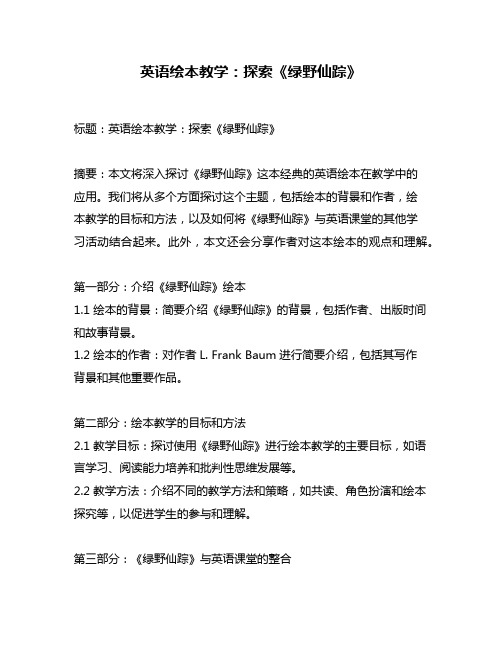
英语绘本教学:探索《绿野仙踪》标题:英语绘本教学:探索《绿野仙踪》摘要:本文将深入探讨《绿野仙踪》这本经典的英语绘本在教学中的应用。
我们将从多个方面探讨这个主题,包括绘本的背景和作者,绘本教学的目标和方法,以及如何将《绿野仙踪》与英语课堂的其他学习活动结合起来。
此外,本文还会分享作者对这本绘本的观点和理解。
第一部分:介绍《绿野仙踪》绘本1.1 绘本的背景:简要介绍《绿野仙踪》的背景,包括作者、出版时间和故事背景。
1.2 绘本的作者:对作者L. Frank Baum进行简要介绍,包括其写作背景和其他重要作品。
第二部分:绘本教学的目标和方法2.1 教学目标:探讨使用《绿野仙踪》进行绘本教学的主要目标,如语言学习、阅读能力培养和批判性思维发展等。
2.2 教学方法:介绍不同的教学方法和策略,如共读、角色扮演和绘本探究等,以促进学生的参与和理解。
第三部分:《绿野仙踪》与英语课堂的整合3.1 词汇和语法:探讨如何利用《绿野仙踪》来教授和巩固英语的词汇和语法知识。
3.2 阅读理解:介绍使用绘本来提高学生阅读理解能力的方法和活动。
3.3 写作和创作:探索如何通过《绿野仙踪》激发学生的写作和创作能力。
第四部分:作者的观点和理解4.1 作者对《绿野仙踪》的独特见解:分享作者对这本绘本的独特见解,包括故事的主题、角色的象征意义等。
4.2 作者对绘本教学的看法:总结作者对绘本教学的看法,以及他认为绘本教学对学生英语学习的重要性。
结论:通过绘本教学,《绿野仙踪》可以成为学生学习英语的有趣和有效的工具。
通过深入研究绘本的背景、作者的见解,以及将绘本与英语课堂活动整合,我们能够帮助学生更好地理解英语语言和文化。
这种综合性的教学方法不仅提高了学生的语言技能,还培养了他们的批判性思维和创造力。
观点和理解:本文作者认为,《绿野仙踪》这本绘本在英语绘本教学中具有重要地位。
绘本教学结合了儿童文学和英语语言学习,可以培养学生的语言技能和阅读能力。
幼儿园英语绘本乐园:《绿野仙踪》启蒙教学计划
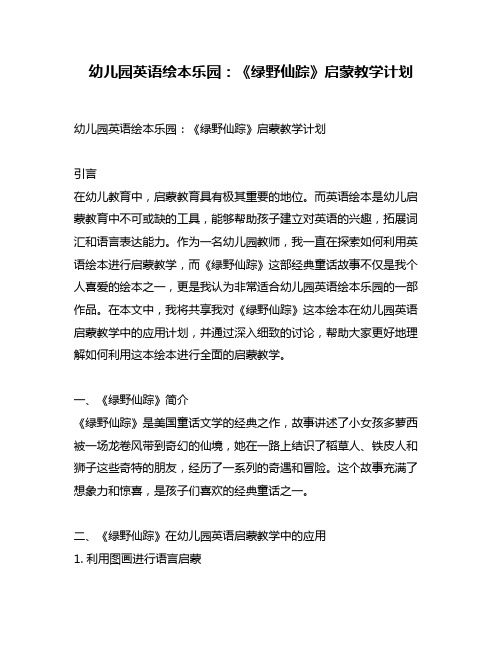
幼儿园英语绘本乐园:《绿野仙踪》启蒙教学计划幼儿园英语绘本乐园:《绿野仙踪》启蒙教学计划引言在幼儿教育中,启蒙教育具有极其重要的地位。
而英语绘本是幼儿启蒙教育中不可或缺的工具,能够帮助孩子建立对英语的兴趣,拓展词汇和语言表达能力。
作为一名幼儿园教师,我一直在探索如何利用英语绘本进行启蒙教学,而《绿野仙踪》这部经典童话故事不仅是我个人喜爱的绘本之一,更是我认为非常适合幼儿园英语绘本乐园的一部作品。
在本文中,我将共享我对《绿野仙踪》这本绘本在幼儿园英语启蒙教学中的应用计划,并通过深入细致的讨论,帮助大家更好地理解如何利用这本绘本进行全面的启蒙教学。
一、《绿野仙踪》简介《绿野仙踪》是美国童话文学的经典之作,故事讲述了小女孩多萝西被一场龙卷风带到奇幻的仙境,她在一路上结识了稻草人、铁皮人和狮子这些奇特的朋友,经历了一系列的奇遇和冒险。
这个故事充满了想象力和惊喜,是孩子们喜欢的经典童话之一。
二、《绿野仙踪》在幼儿园英语启蒙教学中的应用1. 利用图画进行语言启蒙《绿野仙踪》这本绘本精美的图画能够吸引孩子的注意力,通过图画,我们可以向孩子们介绍和复习一些基本的英语词汇,比如风、树、花、小屋等。
通过观察图画,孩子们可以更直观地理解这些词汇,帮助他们建立英语词汇的认知。
2. 讲述故事进行情感启蒙小孩子对故事的接受能力很强,通过向他们讲述《绿野仙踪》这个故事,不仅可以引发他们的想象和好奇心,还能让他们接触到更多的英语语言环境,帮助他们提高英语听力和理解能力。
这个故事中充满了友情、勇气、希望等正能量,有助于培养孩子们的情感素养。
3. 运用角色扮演进行语言交际启蒙《绿野仙踪》中有着多个有趣的角色,比如铁皮人、稻草人和狮子,可以利用这些角色进行角色扮演游戏,帮助孩子们在游戏中练习英语交际,提高他们的口语表达能力,让他们在实践中感受到学习英语的乐趣。
三、总结与回顾通过本文的探讨,我们可以看到《绿野仙踪》这本绘本在幼儿园英语启蒙教学中的重要作用。
绿野仙踪英文启蒙
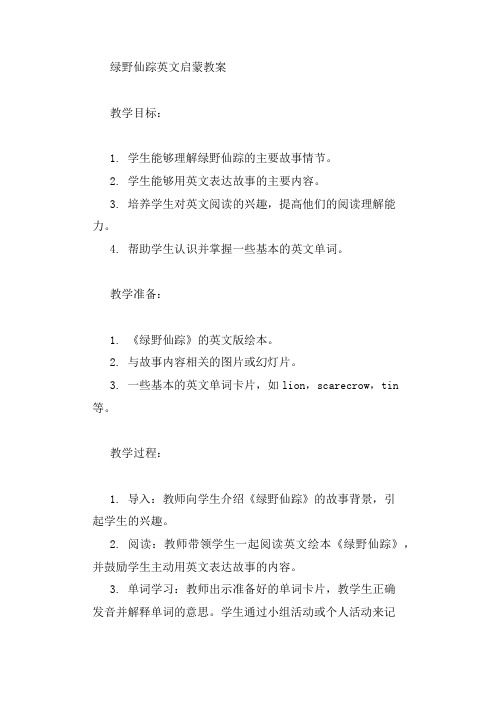
绿野仙踪英文启蒙教案
教学目标:
1. 学生能够理解绿野仙踪的主要故事情节。
2. 学生能够用英文表达故事的主要内容。
3. 培养学生对英文阅读的兴趣,提高他们的阅读理解能力。
4. 帮助学生认识并掌握一些基本的英文单词。
教学准备:
1. 《绿野仙踪》的英文版绘本。
2. 与故事内容相关的图片或幻灯片。
3. 一些基本的英文单词卡片,如lion,scarecrow,tin 等。
教学过程:
1. 导入:教师向学生介绍《绿野仙踪》的故事背景,引
起学生的兴趣。
2. 阅读:教师带领学生一起阅读英文绘本《绿野仙踪》,并鼓励学生主动用英文表达故事的内容。
3. 单词学习:教师出示准备好的单词卡片,教学生正确
发音并解释单词的意思。
学生通过小组活动或个人活动来记
忆和运用这些单词。
4. 图片或幻灯片展示:教师展示与故事内容相关的图片
或幻灯片,让学生用英文描述图片的内容,进一步加深对故
事的理解。
5. 角色扮演:学生分组,选择故事中的角色进行扮演。
通过角色扮演,学生可以更好地理解和表达故事情节。
6. 总结:教师总结本次教学活动,回顾故事的主要内容,鼓励学生在日常生活中多加练习英语表达。
教学评价:
1. 教师观察学生在活动中的参与度和表现,评估学生对
故事的理解程度和英文表达能力。
2. 教师检查学生的英文单词掌握情况,了解学生的学习
成果。
3. 教师通过学生的反馈,不断优化教学方案,提高教学
效果。
- 1、下载文档前请自行甄别文档内容的完整性,平台不提供额外的编辑、内容补充、找答案等附加服务。
- 2、"仅部分预览"的文档,不可在线预览部分如存在完整性等问题,可反馈申请退款(可完整预览的文档不适用该条件!)。
- 3、如文档侵犯您的权益,请联系客服反馈,我们会尽快为您处理(人工客服工作时间:9:00-18:30)。
绿野仙踪英语课外阅读教学设计
Emerald Wonderland: English Extracurricular Reading Lesson Plan
Introduction:
In this English extracurricular reading lesson plan, students will embark on a journey through the enchanting world of "The Wonderful Wizard of Oz" by L. Frank Baum. Through reading and various activities, students will develop their language skills while exploring the themes and characters of this classic tale.
Objective:
To enhance students' English language proficiency and reading comprehension through the study of "The Wonderful Wizard of Oz."
Materials:
1. Copies of "The Wonderful Wizard of Oz" by L. Frank Baum.
2. Classroom projector.
3. Art supplies (coloring pencils, markers, etc.).
4. Whiteboard and markers.
5. Worksheets and handouts prepared in advance.
Procedure:
1. Warm-up activity (5 minutes):
- Begin the lesson with a short discussion about familiar fantasy stories. Ask students about their favorite magical tales and encourage them to share what they find captivating about such stories.
2. Introduction to the book (10 minutes):
- Show the cover of "The Wonderful Wizard of Oz" on the projector and ask students to make predictions about the story based on the illustration. Write down their predictions on the board.
- Briefly introduce the author, L. Frank Baum, and share some background information about the book.
3. Reading activity (25 minutes):
- Divide the students into small groups and distribute copies of the book to each group.
- Instruct the groups to read a designated chapter together silently.
- After reading, have each group summarize their chapter and share their thoughts, impressions, and questions with the whole class.
- Encourage discussions and facilitate comprehension by addressing any confusion or queries raised by students.
4. Character exploration (15 minutes):
- Choose one of the major characters (e.g., Dorothy, Scarecrow, Tin Man, or Cowardly Lion) and discuss their characteristics, motivations, and role in the story with the students.
- Use the whiteboard to create a mind map or character chart as students contribute their ideas.
- Engage the students in a short writing activity where they describe their favorite character from the story and explain why they find them interesting or relatable.
5. Vocabulary expansion (20 minutes):
- Select several key vocabulary words from the chapters read and write them on the board.
- Engage the students in a vocabulary exercise, such as creating sentences using the target words or providing synonyms and antonyms for each term.
- Encourage students to incorporate these new words into their writing and speaking activities throughout the lesson.
6. Artistic interpretation (20 minutes):
- Provide students with art supplies and instruct them to create illustrations or visual representations of a scene or character from the story.
- Encourage creativity and ask students to explain the choices they made in their artwork.
- Allow students to display their artwork around the classroom to create a visual narrative of "The Wonderful Wizard of Oz."
7. Reflection and conclusion (10 minutes):
- Lead a class discussion to elicit students' overall impressions of the story at this point.
- Ask students to share any connections they have made between the events in the book and their own lives or experiences.
- Provide a brief preview of the next reading assignment and conclude the lesson by expressing enthusiasm for their continued exploration of the story.
This English extracurricular reading lesson plan provides students with an interactive and engaging opportunity to delve into the captivating world
of "The Wonderful Wizard of Oz." By integrating various activities and discussions, students will not only enhance their language skills but also develop a deeper understanding of the themes and characters within the story. Through this journey, students will also foster their creativity, critical thinking, and reflective abilities, making their learning experience immersive and enjoyable.。
